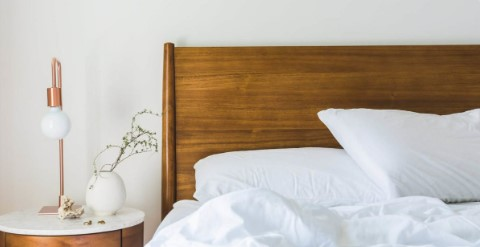
How Clean Is Your Bed
We wash our sheets on a regular basis, but what about keeping the rest of our bed clean? Here are some tips for cleaning your bed to help you have a healthy night’s sleep!
Dusting
It’s easy to overlook this step when you’re cleaning your bed, but it’s important to dust your bedframe about once a month. When you see particles floating in the air on a sunny day, most of them are dead skin cells. Especially if you have allergies, you don’t want your bedframe covered with dust . This could have you coughing and sneezing constantly. Make sure you dust in a direction that brushes the dust outward and away from sheets, pillows, and blankets. (Of course, vacuum the floor after brushing dust onto it.) It’s a good idea to take this step before cleaning the rest of your bed so that if any dust does end up on the bed, you’ll end up removing it when you clean your sheets and mattress.
Caring for your mattress

Take the time to clean your mattress about every six months. You should start by vacuuming the mattress. Then, sprinkle it with baking soda, rub that in with a scrub brush, and let everything sit for ten minutes. Next, you should vacuum your mattress again and remove any stains using these DIY stain removal mixtures. Then, if possible, and if your mattress doesn’t have a pillow top, flip the mattress over and repeat these steps. Even if you don’t notice obvious stains on your mattress, mattresses build up sweat over time. You should also rotate your mattress every three months to a year, unless you have a Tempur-Pedic or Sleep Number mattress.
Washing sheets and pillowcases
Every night, you rest your body on your sheets and lay your head down on your pillow. You probably don’t think about the last time you cleaned your sheets or pillowcase because they don’t appear dirty. At the same time, you wouldn’t wear your clothes for weeks or months on end, but many of us sleep in our beds night after night without cleaning our sheets. Although your bed might look clean, it actually builds up oil and sweat each time you sleep in it. This could contribute to skin issues like acne. For optimal cleanliness, you’ll want to change or wash your sheets once a week or once every two weeks with hot or warm water.
Cleaning blankets and pillows

Check the tags on your comforter and pillows for care instructions that explain how to clean these items. Typically, you can throw both into your washing machine at home using cold water and dry them on low heat. You should wash all the pillows and blankets on your bed at least twice a year. This will protect against dust mites. If you’re feeling sick and spending a lot of time in your bed, make sure to wash everything on the bed once you feel better to remove lingering germs.
Protecting against bleach
Many acne medications contain benzoyl peroxide, which reduces redness of zits because it acts as a bleaching agent. When you wear these products on your face or body during the night, you can stain your sheets, pillowcases, and blankets with bleach. This leaves everything looking discolored and splotchy. You can either opt for white sheets or purchase benzoyl-peroxide resistant sheets, which won’t discolor even if you use bleaching acne medication or other products. You’re free to purchase colorful sheets without staining your pillowcase.
If you’re sleeping eight hours a night, you’re spending about one third of your life in your bed. It’s worth it to spend a little time making sure this is a clean, healthy space for you to spend such a large portion of your time.
